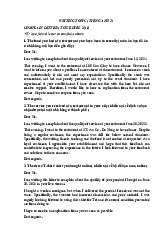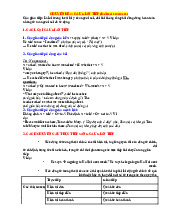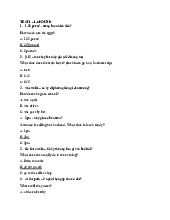






Preview text:
lOMoAR cPSD| 44729304 READING PASSAGE 1
Read the following passage and mark the letter A, B, C, or D on your answer sheet to indicate the
correct answer to each of the questions from 1 to 10.
Culture is a word in common use with complex meanings, and is derived, like the term
broadcasting, from the treatment and care of the soil and of what grows on it. It is directly related to
cultivation and the adjectives cultural and cultured are part of the same verbal complex. A person of
culture has identifiable attributes, among them a knowledge of and interest in the arts, literature, and
music. Yet the word culture does not refer solely to such knowledge and interest nor, indeed, to education.
At least from the 19th century onwards, under the influence of anthropologists and sociologists, the word
culture has come to be used generally both in the singular and the plural (cultures) to refer to a whole way
of life of people, including their customs, laws, conventions, and values.
Distinctions have consequently been drawn between primitive and advanced culture and cultures,
between elite and popular culture, between popular and mass culture, and most recently between national
and global cultures. Distinctions have been drawn too between culture and civilization; the latter is a word
derived not, like culture or agriculture, from the soil, but from the city. The two words are sometimes
treated as synonymous. Yet this is misleading. While civilization and barbarism are pitted against each
other in what seems to be a perpetual behavioural pattern, the use of the word culture has been strongly
influenced by conceptions of evolution in the 19th century and of development in the 20th century.
Cultures evolve or develop. They are not static. They have twists and turns. Styles change. So do fashions.
There are cultural processes. What, for example, the word cultured means has changed substantially since
the study of classical (that is, Greek and Roman) literature, philosophy, and history ceased in the 20th
century to be central to school and university education. No single alternative focus emerged, although
with computers has come electronic culture, affecting kinds of study, and most recently digital culture. As
cultures express themselves in new forms not everything gets better or more civilized.
The multiplicity of meanings attached to the word made and will make it difficult to define. There
is no single, unproblematic definition, although many attempts have been made to establish one. The only
non-problematic definitions go back to agricultural meaning (for example, cereal culture or strawberry
culture) and medical meaning (for example, bacterial culture or penicillin culture). Since in anthropology
and sociology we also acknowledge culture clashes, culture shock, and counter-culture, the range of reference is extremely wide.
1. According to the passage, the word culture________.
A. Is related to the preparation and use of land for farming.
B. Develops from Greek and Roman literature and history.
C. Derives from the same root as civilization does.
D. Comes from a source that has not been identified.
2. It is stated in paragraph 1 that a cultured person_____.
A. has a job related to cultivation.
B. does a job relevant to education
C. takes care of the soil and what grows on it
D. has knowledge of arts, literature, and music
3. The author remarks that culture and civilization are the two words that_____.
A. share the same word formation pattern
B. are both related to agriculture and cultivation
C. do not develop from the same meaning 1 lOMoAR cPSD| 44729304
D. have nearly the same meaning
4. It can be inferred from the passage that since the 20th century______.
A. classical literature, philosophy, and history have not been taught as core subjects
B. classical literature, philosophy, and history have been considered as core subjects
C. schools and universities have not taught classical literature, philosophy, and history
D. all schools and universities have taught classical literature, philosophy, and history
5. The word “attributes” in paragraph 1 most likely means______. A. fields
C. qualities B. skills D. aspects
6. The word “static” in paragraph 2 could best be replaced by “_____”.
A. regular C. unchanged B. balanced D. dense
7. 7. Which of the following is NOT stated in the passage?
A. The word culture can be used to refer to a whole way of life of people.
B. The use of the word culture has been changed since the 19th century.
C. Anthropology and sociology have tried to limit the references to culture
D. Distinctions have been drawn between culture and civilization
8. It is difficult to give the definitions of the word culture EXCEPT for its______.A. agricultural and medical meanings.
B. philosophical and historical meanings.
C. historical and figurative meanings.
D. sociological and anthropological meanings.
9. Which of the following is NOT true about the word culture?A. It differs from the word civilization.
B. It evolves from agriculture
C. Its use has been considerably changed.
D. It is a word that cannot be defined.
10. The passage mainly discusses__________.
A. the multiplicity of meanings of the word culture
B. the distinction between culture and civilization 2 lOMoAR cPSD| 44729304
C. the figurative meanings of the word culture
D. the derivatives of the word culture READING PASSAGE 2 TV Addiction 1 A
The amount of time people spend watching television is astonishing. On average, individuals in
the industrialized world devote three hours a day to the pursuit —fully half of their leisure time,
and more than on any single activity save work and sleep. At this rate, someone who lives to 75
would spend nine years in front of the tube. To some commentators, this devotion means simply
that people enjoy TV and make a conscious decision to watch it. But if that is the whole story,
why do so many people experience misgivings about how much they view? In Gallup polls in
1992 and 1999, two out of five adult respondents and seven out of 10 teenagers said they spent
too much time watching TV. Other surveys have consistently shown that roughly 10 percent of
adults call themselves TV addicts. B
To study people’s reactions to TV, researchers have experiments in which they have monitored the
brain waves (using an electroencephalograph, or EEG) to track behavior and emotion in the
normal course of life, as opposed to the artificial conditions of the lab. Participants carried a beeper,
and we signaled them six to eight times a day, at random, over the period of a week; whenever
they heard the beep, they wrote down what they were doing and how they were feeling using a standardized scorecard. C
As one might expect, people who were watching TV when we beeped them reported feeling
relaxed and passive. The EEG studies similarly show less mental stimulation, as measured by
alpha brain-wave production, during viewing than during reading. What is more surprising is that
the sense of relaxation ends when the set is turned off, but the feelings of passivity and lowered
alertness continue. Survey participants say they have more difficulty concentrating after viewing
than before. In contrast, they rarely indicate such difficulty after reading. After playing sports or
engaging in hobbies, people report improvements in mood. After watching TV, people’s moods
are about the same or worse than before. That may be because viewers’ vague learned sense that
they will feel less relaxed if they stop viewing. So they tend not to turn the set off. Viewing begets
more viewing which is the same as the experience of habit-forming drugs. Thus, the irony of TV:
people watch a great deal longer than they plan to, even though prolonged viewing is less
rewarding. In our ESM studies the longer people sat in front of the set, the less satisfaction they
said they derived from it. For some, a twinge of unease or guilt that they aren’t doing something
more productive may also accompany and depreciate the enjoyment of prolonged viewing.
Researchers in Japan, the U.K. and the U.S. have found that this guilt occurs much more among
middle-class viewers than among less affluent ones. D
What is it about TV that has such a hold on us? In part, the attraction seems to spring from our
biological ‘orienting response/ First described by Ivan Pavlov in 1927, the orienting response is
our instinctive visual or auditory reaction to any sudden or novel stimulus. It is part of our
evolutionary heritage, a built-in sensitivity to movement and potential predatory threats. In 1986
Byron Reeves of Stanford University, Esther Thorson of the University of Missouri and their 3 lOMoAR cPSD| 44729304
colleagues began to study whether the simple formal features of television—cuts, edits, zooms,
pans, sudden noises — activate the orienting response, thereby keeping attention on the screen.
By watching how brain waves were affected by formal features, the researchers concluded that
these stylistic tricks can indeed trigger involuntary responses and ‘derive their attentional value
through the evolutionary significance of detecting movement…. It is the form, not the content, of television that is unique. E
The natural attraction to television’s sound and light starts very early in life. Dafna Lemish of Tel
Aviv University has described babies at six to eight weeks attending to television. We have
observed slightly older infants who, when lying on their backs on the floor, crane their necks
around 180 degrees to catch what light through yonder window breaks. This inclination suggests
how deeply rooted the orienting response is. F
The Experience Sampling Method permitted us to look closely at most every domain of everyday
life: working, eating, reading, talking to friends, playing a sport, and so on. We found that heavy
viewers report feeling significantly more anxious and less happy than light viewers do in
unstructured situations, such as doing nothing, daydreaming or waiting in line. The difference
widens when the viewer is alone. Subsequently, Robert D. Mcllwraith of the University of
Manitoba extensively studied those who called themselves TV addicts on surveys. On a measure
called the Short Imaginal Processes Inventory (SIPI), he found that the selfdescribed addicts are
more easily bored and distracted and have poorer attentional control than the non-addicts. The
addicts said they used TV to distract themselves from unpleasant thoughts and to fill time. Other
studies over the years have shown that heavy viewers are less likely to participate in community
activities and sports and are more likely to be obese than moderate viewers or non-viewers. G
More than 25 years ago psychologist Tannis M. MacBeth Williams of the University of British
Columbia studied a mountain community that had no television until cable finally arrived. Over
time, both adults and children in the town became less creative in problem solving, less able to
persevere at tasks, and less tolerant of unstructured time. H
Nearly 40 years ago Gary A. Steiner of the University of Chicago collected fascinating individual
accounts of families whose set had broken. In experiments, families have volunteered or been paid
to stop viewing, typically for a week or a month. Some fought, verbally and physically. In a review
of these cold-turkey studies, Charles Winick of the City University of New York concluded: ‘The
first three or four days for most persons were the worst, even in many homes where viewing was
minimal and where there were other ongoing activities. In over half of all the households, during
these first few days of loss, the regular routines were disrupted, family members had difficulties
in dealing with the newly available time, anxiety and aggressions were expressed By the second
week, a move toward adaptation to the situation was common.’ Unfortunately, researchers have
yet to flesh out these anecdotes; no one has systematically gathered statistics on the prevalence of these withdrawal symptoms. I
Even though TV does seem to meet the criteria for substance dependence, not all researchers
would go so far as to call TV addictive. Mcllwraith said in 1998 that ‘displacement of other
activities by television may be socially significant but still fall short of the clinical requirement of
significant impairment.’ He argued that a new category of ‘TV addiction’ may not be necessary if
heavy viewing stems from conditions such as depression and social phobia. Nevertheless, whether 4 lOMoAR cPSD| 44729304
or not we formally diagnose someone as TV-dependent, millions of people sense that they cannot
readily control the amount of television they watch. Questions 11-15
Do the following statements agree with the claims of the writer in Reading Passage? In boxes
11-15 on your answer sheet, write
TRUE if the statement is true
FALSE if the statement is false
NOT GIVEN if the information is not given in the passage
11 Study shows that males are more likely to be addicted to TV than females. => Not given 12
Greater improvements in mood are experienced after watching TV than playing sports. => False
13 TV addiction works in similar ways as drugs. => True
14 It is reported that people’s satisfaction is in proportion to the time they spend watching TV. => False
15 Middle-class viewers are more likely to feel guilty about watching TV than the poor. => True Questions 16-20
Look at the following researchers (Questions 16-20) and the list of statements below.
Match each researcher with the correct statements.
Write the correct letter A-H in boxes 19-23 on your answer sheets.
16 Byron Reeves and Esther Thorson => F
17 Dafna Lemish => B
18 Robert D. Mcllwraith => G
19 Tannis M. MacBeth Williams => C
20 Charles Winick => H List of Statements
A Audiences would get hypnotized from viewing too much television.
B People have been sensitive to the TV signals since a younger age.
C People are less likely to accomplish their work with television.
D A handful of studies have attempted to study other types of media addiction.
E The addictive power of television could probably minimize the problems.
F Various media formal characters stimulate people’s reaction on the screen.
G People who believe themselves to be TV addicts are less likely to join in the group activities.H
It is hard for people to accept the life without TV at the beginning. Questions 21-23
Choose the correct letter, A, B, C or D. Write the correct letter in boxes 21-23 on your answer sheet.
21 People in the industrialized world
A devote ten hours watching TV on average.
B spend more time on TV than other entertainment. C call themselves TV addicts. D working best. 5 lOMoAR cPSD| 44729304
22 When compared with light viewers, heavy viewers
A like playing sport more than reading.
B feel relaxed after watching TV.
C spend more time in daydreaming.
D are more easily bored while waiting in line.
23 Which of the following statements is true about the family experiment?
A Not all the subjects participate in the experiment for free.
B There has been a complete gathered data.
C People are prevented from other activities during the experiment.D People cannot adapt to the situation until the end READING PASSAGE 3
Read the following passage and mark the letter A,B,C or D to indicate the correct answer
for each of the blanks.
THE NEED FOR BIGGER PLANES
The big issue for plane-makers planning for the future is size, not speed. With the skies already
full of air traffic, and with worse to (24)_________ , the important questions for the designers are
how many passengers they can fit into the new super-planes and who will be (25)______to build them first.
Imagine yourself ten years from now in a packed airport departure lounge. Eight hundred
passengers are waiting with you for their first flight on one of a remarkable range of superplanes,
and the check-in time (26)__________ have been as much as four hours before take-off to allow
for the extra people. Impossible? Far from it. Designs for these planes are already
(27)_________ on computer at the world’s top aircraft manufacturers, waiting to be turned (28)_________ reality.
The airlines badly need the new jets to (29)________ with future increases in passenger
(30)________ . A billion passengers a year are currently carried by air, but that figure is
(31)___________ to double by the year 2020. The only practical (32)_______ of avoiding
making the skies even busier is to build much bigger planes. The (33)______ to build the new
jets is the hottest contests in the airliner business. Manufacturers are working (34)______ with
the major airlines to produce designs that will please airlines and passengers (35)________.
24. A. go B. happen C. arrive D. come
25. A. possible B. able C. proper D. capable
26. A. can B. need C. ought D. may
27. A. supplied B. given C. stored D. carried
28. A. as B. by C. into D. for
29. A. deal B. treat C. manage D. succeed
30. A. amounts B. sums C. quantities D. numbers
31.A. thought B. expected C. known D. hoped
32. A. scheme B. process C. way D. plan
33. A. game B. sport C. match D. race
34. A. tightly B. closely C. strongly D. firmly 6 lOMoAR cPSD| 44729304
35. A. equal B. alike C. similar D. same. 7




